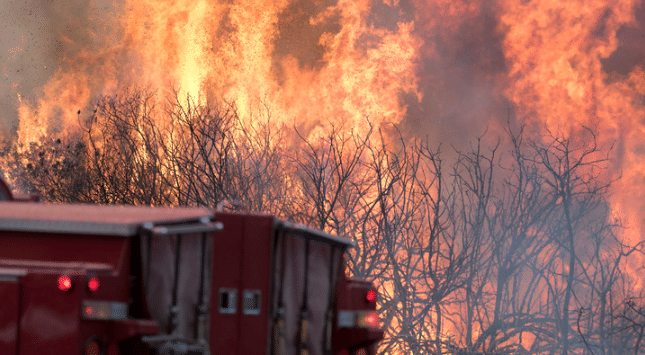When there’s a wildfire near your home, every second counts. Leaving quickly can help you steer clear of thick smoke, dangerous conditions, and even traffic jams as everyone heads to safety. The key to a quick exit lies in preparation—having a well-thought-out plan and essential items ready to go.
Pre-Evacuation Prep
Follow this general guide to know what to pack. Keep this as a checklist and refer to it as you assemble everything that you need.
Food and Water
- Put together a 3-day supply of food for everyone in your family (unless you’re going to a relative’s or friend’s home who lives far away from the fire zone).
- Bring 3 gallons of water per person.
- Pack utensils and bowls, as you don’t know what might be available in emergency shelters.
Pet Supplies
- Pack kibble, bowls and bring water for pets.
- Bring a leash, collar, pet bed, crate or carrier, litter box, and litter as needed for your pet. Include treats and toys.
- Pack pet medications.
- Check that your pet’s microchip details are up to date.
- Bring contact information for your pet’s vet and/or your pet’s vaccine records.
Medicine and Hygiene
- Bring prescription medications and any medicines that your family may use on a regular basis: pain relievers, allergy medicines, contact lenses and solution, inhalers, etc.
- Pack hygiene items such as shampoo, soap, deodorant, toothbrushes, toothpaste, disposable razors, shaving cream, and towels.
- For infants and toddlers, bring diapers and baby wipes.
Safety
- Keep a first aid kit in your car should you need it.
- Include N95 masks if available to limit your exposure to smoke.
- Pack flashlights and batteries.
Clothing and Bedding
- Pack for practicality and safety. Layer clothes for a range of temperatures. Don’t forget PJs, socks, and underwear, as well as a raincoat or all-weather jacket.
- Comfortable, closed toed shoes work best in emergency situations.
- Bring sleeping bags, pillows and blankets. Include a portable crib for infants and toddlers.
Electronics
- Bring chargers for smartphones, laptops, and devices. Include a solar charger if you have one.
- Keep your devices well charged before you leave so you won’t have to search for a place to charge.
- Pack a battery powered radio and spare batteries in case the power goes out.
Special items
- There are some things you that you cannot replace. If you have the room, and they are easy to carry, plan to bring up to 3-5 of these special items.
- Your planning time is a good time to do a home inventory of all your possessions. Take pictures and notes of big items. This will help if your home is partially or completely destroyed by a wildfire, and you need to file a claim.
Documents
- Prepare a binder with key documents: mortgage or rental agreement, insurance policies, birth certificates, passports, bank information, and investments.
- Make sure your wallet or purse has your driver’s license, registration, health insurance cards, debit and credit cards.
- Complete a cell phone list for neighbors, family. Designate a person outside the wildfire area who can be the main contact should family members get separated or have trouble with cell service.
- Make copies of everything and keep them in a secure password protected digital space.
Prepare Your Home & Vehicle
During a wildfire, embers can travel quickly and ignite your home and property. Here are some steps to take to prepare your home and vehicle.
- Keep the vehicle that you’ll be leaving in fully gassed and well maintained. Park it in the direction it needs to go when you leave.
- Make sure that you know how to manually open the garage door in case you lose power.
- Make sure everyone in the household knows what to do to quickly evacuate.
- Close all windows. Close all interior doors.
- Take down flammable window treatments like curtains and store them out of the way.
- Turn off the gas and pilot lights. Shut off propane tanks.
- Turn off your air conditioning.
- Leave lights on to allow firefighters to see your home in the dark.
- Bring potentially flammable outside furnishings, toys and doormats inside or place them in your pool.
- Attach garden hoses to outside taps for firefighters to use. Placed filled buckets of water around your home.
- Listen to first responders and be ready to act when they recommend evacuation.
Pro Tip: California Casualty policyholders may be able to get immediate help if they are evacuated by fire. Evacuation expenses, such as hotel or other temporary housing, and meals are reimbursable with most policies.
Review your wildfire evacuation plan often. Keep it updated as your family grows and needs change. Finally, protect your home with the right insurance for added peace of mind.
This article is furnished by California Casualty, providing auto and home insurance to educators, law enforcement officers, firefighters, and nurses. Get a quote at 1.866.704.8614 or www.calcas.com.
- Hazards in Older Homes - December 30, 2025
- Creative Storage Hacks for Small Apartments - December 26, 2025
- Tires 101: Rotation, Alignment and Balancing Explained - December 22, 2025

